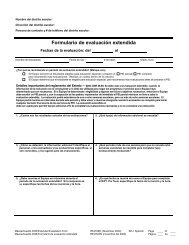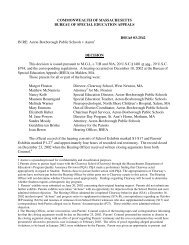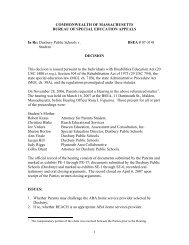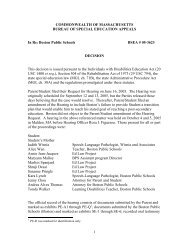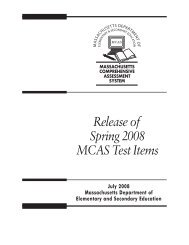IV. English Language Arts, Reading Comprehension, Grade 5
IV. English Language Arts, Reading Comprehension, Grade 5
IV. English Language Arts, Reading Comprehension, Grade 5
You also want an ePaper? Increase the reach of your titles
YUMPU automatically turns print PDFs into web optimized ePapers that Google loves.
<strong>Reading</strong> <strong>Comprehension</strong><br />
6<br />
7<br />
8<br />
9<br />
10<br />
go to drink nectar, and the pollen sticks to their<br />
feathers or beaks. Colorful but unscented flowers<br />
also appeal to bees, wasps, and butterflies, which<br />
look for blossoms of particular colors and shapes<br />
and not just scent. And if a flower smells—and<br />
sometimes even looks—bad, it lures flies, carrion<br />
beetles, or other critters that love the putrid odor of<br />
rotten meat or fish.<br />
Going Batty!<br />
Flies and beetles aren’t the only creatures<br />
attracted to smelly flowers. Many plants are<br />
pollinated by bats. What odors do bats prefer?<br />
Some like the smell of rotting fruit. And some like<br />
the musty aroma of fellow bats.<br />
In Africa, the baobab tree (Adansonia digitata)<br />
produces gorgeous blossoms that reek rather like<br />
these flying mammals. Because bats are nocturnal,<br />
the flowers open at night and are pale in color so<br />
the bats can see (and smell) them more easily. While they are eating the flowers’ nectar, the pollen<br />
sticks to the bats’ fur or mouths. As they fly from bloom to bloom, they transfer it.<br />
The baobab is a magnificent and important plant. Animals live in its branches. People use<br />
all of it—the bark for cloth and rope, the leaves for medicine, the fruit for food—and sometimes<br />
even take shelter inside its huge trunk.<br />
Another important relative of the baobab is the<br />
silk cotton tree (Ceiba pentandra). This tree’s fruits<br />
produce kapok—a fluffy material once widely used in<br />
lifejackets, sleeping bags, quilts, mattresses, and pillows<br />
because it is buoyant and warm. In many places the<br />
wood is still used to make canoes. Like the baobab, the<br />
kapok has malodorous flowers that attract bats. In some<br />
places, bats appear to be the plant’s only pollinator and<br />
seed disperser. Eliminate the bats, and you eliminate<br />
the tree—one of many good reasons to protect these<br />
mammals.<br />
Baobab and kapok blossoms, like carrion flowers,<br />
certainly smell great to their animal pollinators, but<br />
there’s a good chance Mom won’t like them. So when it<br />
comes to Mother’s Day, it’s best to stick with roses.<br />
“Foul Flora” by Marilyn Singer, from What Stinks? Copyright © 2006 by Marilyn Singer. Reprinted by permission of Darby Creek, a division<br />
of Lerner Publishing Group, Inc. Photograph 1 copyright © iStockphoto/wrangel. Photograph 2 copyright © iStockphoto/jeu. Photograph 3<br />
copyright © iStockphoto/Angela Bell.<br />
42<br />
field of baobab trees<br />
kapok blossom






